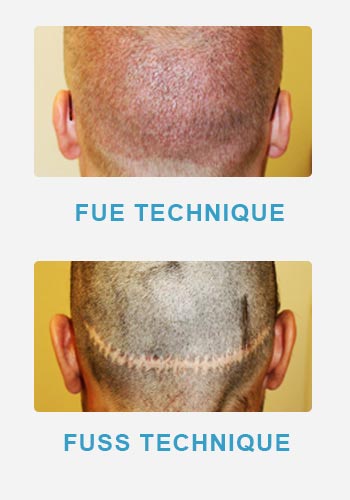The FUSS hair transplant (or strip technique) and the FUE method are two of the most commonly used procedures of hair transplant in Delhi to solve alopecia today. Thousands of men and women have undergone these interventions after abnormal hair loss at hair transplant center in Delhi. But which one is the most appropriate in each case? Is there a better hair grafting technique than another?
We explain to you how the FUE (Follicular Unit Extraction) technique is carried out and what is the FUSS (Follicular Unit Strip Surgery), with its differences, advantages, disadvantages and marks after the intervention.
How the FUSS technique works
The FUSS technique, also known as the “strip technique”, is a hair implant method in which a section of hair from the donor area is removed with a scalpel by hair transplant surgeon in Delhi, what we know as a hair band. The wound caused by the removal of the strip, which is usually located in the occipital area of the skull, is closed by stitches or staples, which are removed after 12-15 days.
Once the hair band has been obtained, it is divided into follicular units (part of the skin that gives rise to the hair) that will be transplanted in the receiving area that is desired to be populated. To do this, millimeter incisions are made in the implant area by hair transplant doctor in Delhi with each of the follicular units.
The drawback of the scar in the FUSS technique
The length of the strip removed in the FUSS technique can range between 15 and 35 centimeters, depending on the follicles to be implanted. Its width is 0.5 to 2 centimeters.
Obtaining this strip causes one of the main drawbacks of the FUSS technique: the scar. This residual scar may be visible after hair grafting, especially in patients who wish to wear short hair.
The FUSS procedure is much faster to perform (between 4 and 8 hours) than the FUE, however, the FUE is much more accurate than the previous one since it leaves no signals and allows more capillary units to be extracted, since there are more areas available on the head than with the strip.
But the main difference is healing, the FUE technique is much faster. The reason is that in this advanced procedure only micro wounds are created that do not require sutures as in the FUSS, thus avoiding the dreaded scar. Because the FUE hair graft technique does not use scalpels or sutures to perform the procedure, patients' scars heal within a day or two.
Thus, although it takes longer to perform the intervention, the results with the FUE are better both aesthetically (without scar) and in terms of hair unit extraction (up to 5,000 follicles).
Alternatives to FUSS: FUE method and DHI method
The alternatives to the most advanced FUSS method today are the one named FUE and the DHI technique, in both cases, hair grafts that do not leave scars:
- FUE method
FUE hair transplant in Delhi consists of transplanting follicular units from the donor area to the recipient area, which is the one that suffers from alopecia. It is one of the most advanced techniques and is carried out with a micro graft procedure of the hair follicle.
The FUE technique allows treating the problem of alopecia in both men and women as long as they meet the requirements: the ideal candidates are people with hair loss in specific areas (such as entrances) and controlled. That is, a patient suffering from alopecia in the whole head or in most, could not access the FUE procedure.
- DHI method
This is one of the latest advances in hair transplant in South Delhi. The DHI technique is performed using a tool (Implanter or Choi Pen) and consists of implanting the follicles directly into the recipient zone one by one. This technique stands out for its great precision and as an ideal method to fill the most specific and localized areas. However, no more than 2,500-3,000 follicles can be implanted, so the number of follicles is smaller compared to the FUE technique.

No comments:
Post a Comment